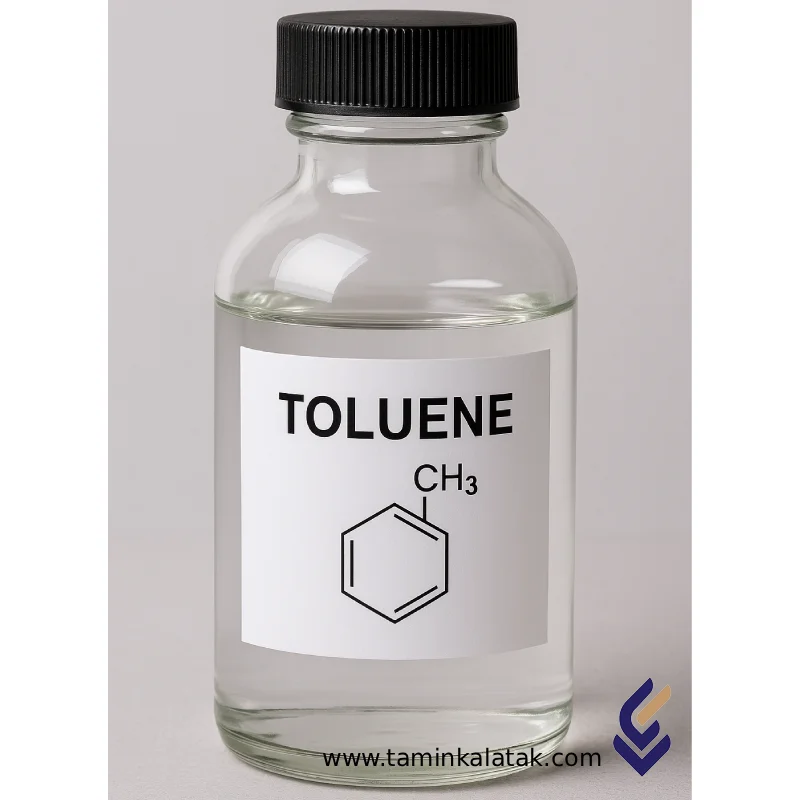Toluene
Toluene is an organic chemical compound belonging to the family of aromatic hydrocarbons, with the chemical formula C₆H₅CH₃ or C₇H₈.
It is a colorless, volatile, and highly flammable liquid with an odor similar to paint thinners.
Due to its unique properties, toluene is one of the most widely used industrial chemicals — serving as a powerful solvent and a raw material in the paint, adhesive, polymer, pharmaceutical, and fuel industries.
Structure of Toluene
Toluene consists of a benzene ring attached to a single methyl group (–CH₃).
This structure imparts both aromatic stability and alkyl reactivity, allowing it to participate in various chemical reactions.
-
Molecular Formula: C₇H₈
-
Chemical Structure: Benzene ring with one methyl substituent
-
IUPAC Name: Methylbenzene
-
CAS Number: 108-88-3
Physical and Chemical Properties of Toluene
-
Appearance: Clear, colorless, volatile liquid with a sweet, pungent odor
-
Molecular Weight: 92.14 g/mol
-
Density (20°C): 0.866–0.870 g/cm³
-
Boiling Point: 110.6°C
-
Melting Point: −95°C
-
Vapor Pressure (20°C): 28–30 mmHg
-
Water Solubility: Slight (~0.52 g/L at 25°C)
-
Solubility in Organic Solvents: Completely miscible with acetone, ethanol, ether, and most organic solvents
-
Flammability: Highly flammable (flash point ≈ 4°C)
Advantages of Toluene
-
Excellent solvency power for a wide range of organic compounds
-
Cost-effective and readily available on an industrial scale
-
High compatibility with diverse chemical processes
-
Essential role as an intermediate in the production of numerous industrial and pharmaceutical materials
Disadvantages and Limitations
-
Moderate toxicity to humans (especially with prolonged inhalation or skin contact)
-
Direct effects on the central nervous system (dizziness, headache, drowsiness)
-
Environmental hazard in case of accidental spills or improper disposal
-
High flammability requiring strict safety and storage measures
Applications of Toluene
-
Paints, Varnishes, and Thinners: As a major solvent component
-
Printing and Ink Industry: Used to dissolve resins and pigments
-
Polymer Manufacturing: In the production of polyurethanes, nylon, and synthetic resins
-
Chemical Synthesis:
-
Benzene (via dealkylation)
-
Trinitrotoluene (TNT)
-
Benzoic acid and its derivatives
-
-
Pharmaceutical Industry: As an intermediate in the synthesis of active pharmaceutical ingredients (APIs)
-
Fuel Additive: Used to improve octane rating in gasoline formulations
Safety and Handling of Toluene
-
GHS Classification: Flammable liquid; hazardous to human health and the environment
Hazard Statements (H-Codes):
-
H225: Highly flammable liquid and vapor
-
H304: May be fatal if swallowed and enters airways
-
H315: Causes skin irritation
-
H336: May cause drowsiness or dizziness
-
H361d: Suspected of damaging the unborn child
-
H373: May cause damage to organs through prolonged or repeated exposure
Required Personal Protective Equipment (PPE)
-
Chemical-resistant gloves (nitrile or butyl rubber)
-
Safety goggles or face shield
-
Respiratory protection in areas with high vapor concentration
-
Solvent-resistant protective clothing
Storage Conditions
-
Store in a cool, dry, and well-ventilated area
-
Keep away from heat sources, sparks, and open flames
-
Use sealed metal or glass containers resistant to solvents
Emergency Measures
-
Inhalation: Move the person to fresh air and seek medical attention
-
Skin Contact: Wash thoroughly with soap and water
-
Eye Contact: Rinse immediately with plenty of water and get medical assistance
-
Ingestion: Do not induce vomiting; seek immediate medical attention
Applications
| Applications | , , , , , |
|---|
Toluene
| Products | Chemical formula | CAS number | Grade | Vapor pressure | Physical appearance | Solubility in water | Density (at 20°C) | Melting point |
|---|---|---|---|---|---|---|---|---|
| Toluene – methylbenzene | C₆H₅CH₃ یا C₇H₈ | 108-88-3 | Industrial, laboratory, pharmaceutical, HPLC grade | ~28–30 mmHg | Clear, colorless, volatile liquid with a sweet, penetrating odor. | Very slightly soluble (~0.52 g/L at 25 °C); soluble in most organic solvents | ~0.866–0.870 g/cm³ | −95 °C |







